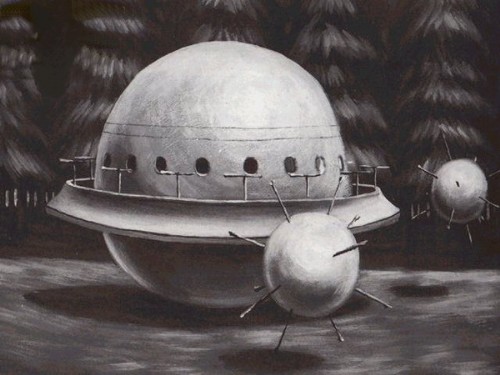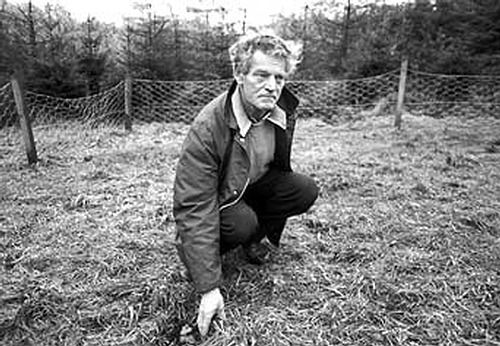Date:
November 9, 1979
Location: Livingston, Scotland, United Kingdom
Robert
Taylor, a forester from West Lothian, Scotland, encountered
a strange object and equally strange smaller objects or
"entities". The rounded larger object, 20 feet
in diameter, hovered above the ground. Then, two small
objects, which were round but had appendages, "rushed"
toward him. These objects each attached itself to one
(each) of his trouser legs and tugged him towards the
larger object, at which time Taylor lost consciousness.
Ground marks were discovered at the scene of the encounter.

An artist's impression of the craft and 'mines' Taylor
described, based on sketches he drew
after the encounter.

Plan of site markings from police measurements. The shading
inside the small circles
indicate the top side of angled holes. Six meter diameter
circle is assumed position of UFO.
(credit: APRO)

The witness, Robert Taylor, examines the strange marks
on the ground that were left by the
objects. (Credit: The Economist)
Source:
APRO, July 1980
THE
SCOTTISH LANDING CASE
The
February 1980 (Vol. 28, #8) issue of the Bulletin contained
a preliminary report on the alleged encounter of a West
Lothian, Scotland forester with a strange object and equally
strange smaller objects or "entities".
The "happening" took place on November
9, 1979, and the following is the information gleaned
from additional clippings and mainly from the Journal
of Transient Aerial Phenomena, Vol. 1, No. 2, March, 1980.
Strangely enough, the article was written by Stuart Campbell,
the architect who initially identified the object(s) as
manisfestation(s) of ball lightning. However, it does
seem that Mr. Campbell is being fairly objective, and
the following are the "gleanings". We
refer the readers to the February, 1980 (Vol. 28, #8)
issue of the Bulletin to save space and repetition.
Robert
Taylor, forester, (sixteen years tenure with the Livingston
Development Corporation) and now a foreman, left his home
in Lothian at 10:00 GMT in a Forestry Department van,
to inspect young trees to the North of the town near highway
M8. As he could not drive the van all the way due to the
density of trees, he left it on the side of the roadway
and proceeded on foot.
Mr.
Taylor, accompanied by his dog — walked the rest
of the way, and at about 10:15 he rounded a corner in
the forest path (100 meters from the road but out of sight
of it) and came upon a strange sight.
Before
him was a rounded object with a rim-like appendage (according
to Journal of Transient Aerial Phenomena) not unlike a
circular platform (see drawing, reproduced from JTAP,
artist not identified).
At
first, the smaller objects were not in evidence, according
to Taylor. The larger object was hovering above the ground,
neither moving nor making any sound. The "thing"
was dark grey with a texture similar to that of sand-paper.
It appeared to become transparent in one area or another,
seemingly, to Taylor, to "camouflage"
itself. The "craft" was estimated to
be twenty feet (six meters) in diameter.
Taylor
said he stood, amazed, and stared at the object, then
two small objects (apparently coming from under the large
object) "rushed" toward him. They had
a color and texture similar to that of the "parent"
object, but were outfitted with appendages (see figure
1). They rolled on a horizontal axis and made a "plopping"
noise as the "legs" made contact with
the ground.
Upon
reaching him, these objects each attached itself to one
(each) of his trouser legs, just below the pockets on
the sides. Taylor felt them tug him toward the large object
and at the same time, he said, he was nearly suffocated
by a strong acrid smell which he compared with that of
burning automobile brake linings and which he felt came
from the "things".
Taylor
became aware that he was being dragged forward and his
boots were scraping on the ground, before he lost consciousness,
and fell forward and laid face downwards.
When
Taylor regained consciousness, the objects were gone,
but his dog was with him. He tried to speak to her but
found he had lost his voice. He tried to stand, but his
legs would not support him, so he crawled approximately
90 meters (300 ft.) back up the trail toward his van,
and then unsteadily half crawled and half staggered the
rest of the 430 meters to his van. There, he attempted
to contact his headquarters via two-way radio but was
unsuccessful because of his voice.
Taylor
then attempted to back the van up the track but unfortunately,
he ran off the track onto soft ground and could not get
it out. Using short cuts through woods and fields, he
walked the remaining 1,600 meters back to his home, arriving
at 11:30 a.m. During his walk between his van and his
home, his voice returned.
Upon
seeing her husband's state when he arrived home, Mrs.
Taylor assumed he had been attacked and started to call
the police, but Taylor stopped her and had her call Mr.
Malcolm Drummond, the head of the Forestry Department
and his superior. Drummond immediately went to the Taylor
residence and he and Taylor went back to the scene of
the encounter where they found strange holes in the ground,
which Taylor said had not been there before, that morning.
Mrs. Taylor had noticed some unaccountable tears in his
trousers in the areas where Taylor claimed the small objects
had attached themselves.
Mr.
Taylor was later examined by his Doctor who found only
a "graze" (scrape?) on his chin and on
his thigh. The Doctor sent him to the Bangour hospital
for a skull X-ray, but Taylor checked himself out before
this was accomplished. (Editor's note: This may strike
some readers as odd, but if Scottish hospitals are anything
like American ones, any tests except for those required
in dire emergencies, are only undertaken on weekdays and
it is possible Taylor didn't relish a hospital stay over
the weekend for an X-ray, especially if he had no pain
in his head, and so far the reports do not indicate that
he did).
The
following excerpts were taken from the "Journal
of Transient Aerial Phenomena" with their permission:
"The
ground marks (see Figure 2) were of two types. First,
there were two isolated ladder type "tracks"
about 2.5 m long and the same distance apart. Each "rung"
of the ladder (see Photograph 1), was 2 or 3 cm wide and
deep, and about 30 cm long, and the area of grass between
each "rung" was evenly flattened, but not as
deeply as the "rungs". Although the "tracks"
appear to be impressions made by a heavy object, the indentations
were only in the grass; they did not alter the ground
profile under the grass as they would have done if subjected
to a heavy weight. The grass blades were each folded and
formed to follow the outline of a rectangular indentations."
"Secondly,
there were 40 holes surrounding the "tracks",
as shown in Figure 2. These holes all exposed fresh earth
and were tapered from a maximum width of about 10 cm,
but at an angle as shown, The angle was fairly shallow;
about 30° to the horizontal. A remarkable feature
was the fact that the direction of the angle of the holes
was consistent and always in line with the next hole in
line. Two distinct and related sets of holes can be detected,
and it is clear that one set of holes proceeds clock-wise,
while the other proceeds anticlock-wise, and that they
are in tandem between the "tracks". In some
cases, blades of grass surrounding the edge of a hole
were sheared off."
"No
grass was scorched. The marks were measured and recorded
by the local police the same day, and the area fenced
off by the Forestry Department. The marks were photographed
by Alastair Sutherland (a friend of a member of the Forestry
Department) and by me, the following day."
"Robert
Taylor's clothes (including the trousers) were taken by
the police for forensic examination. Only the trousers
and his long underpants showed anything unusual.Figure
4 and 5 show the tears on each leg of the trousers, which
are made of navy blue serge. The right leg tear is about
65 cm up from the bottom of the leg, while the left tear
is about 76 cm up."
Source:
http://www.ufoevidence.org/cases/case682.htm
